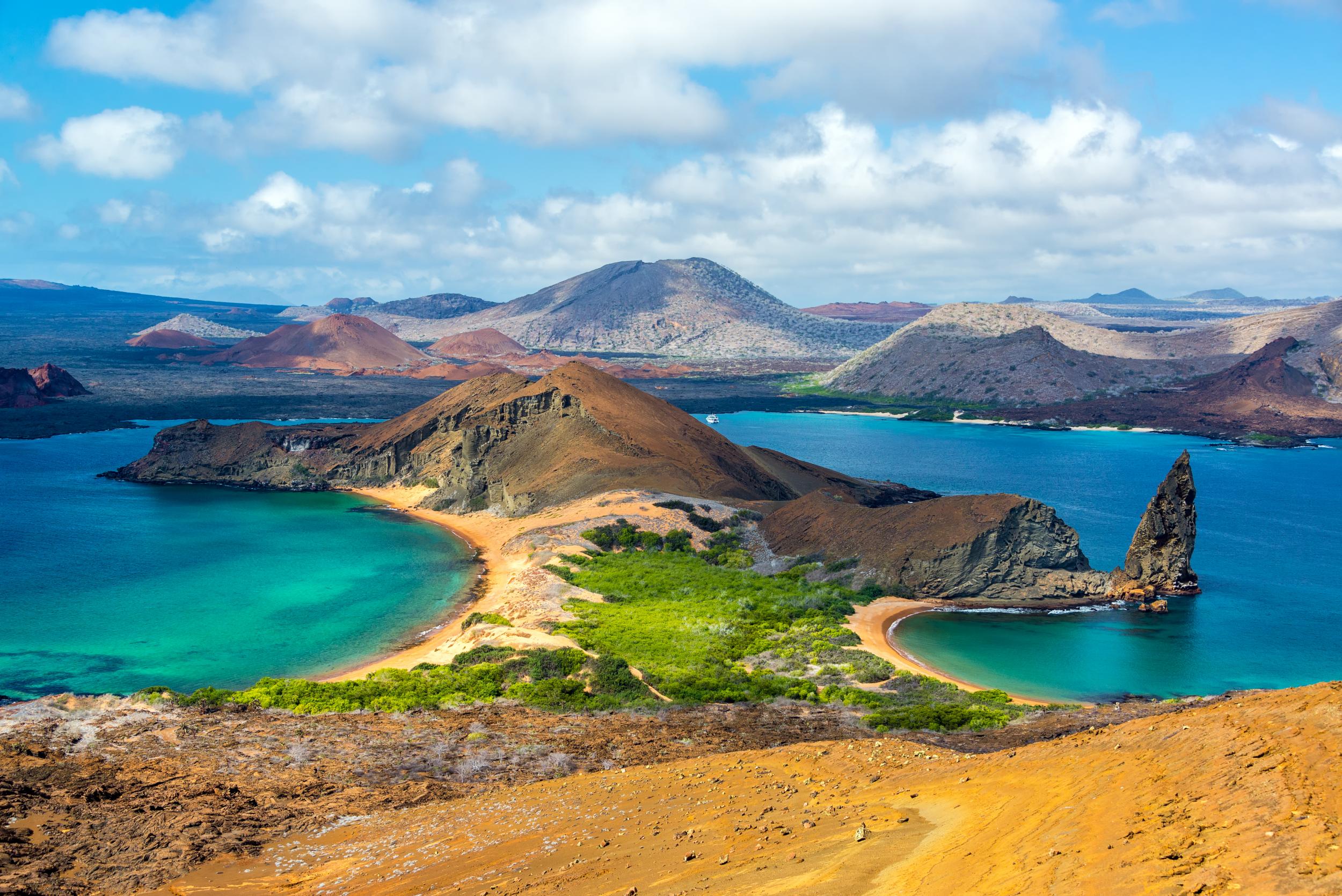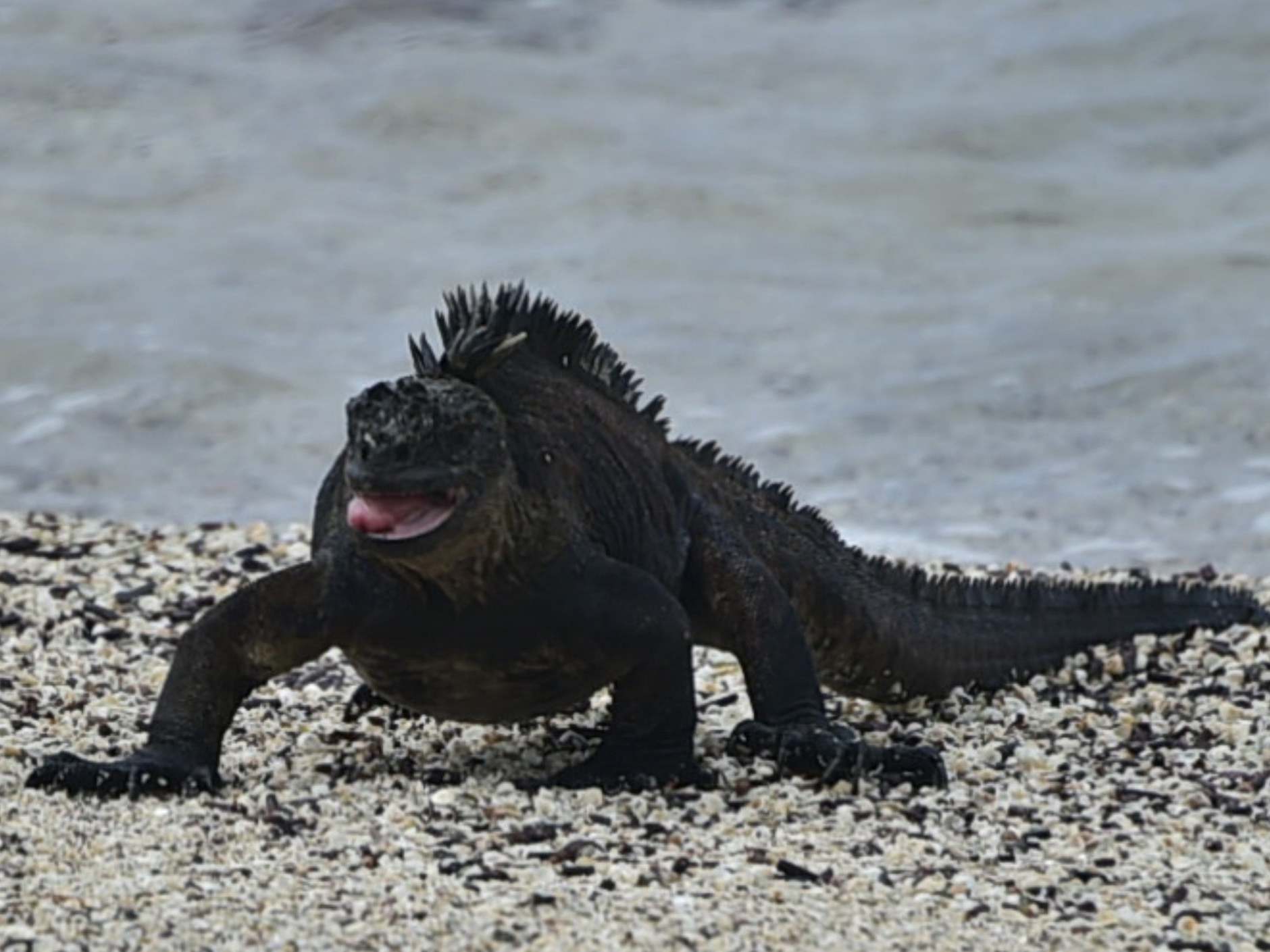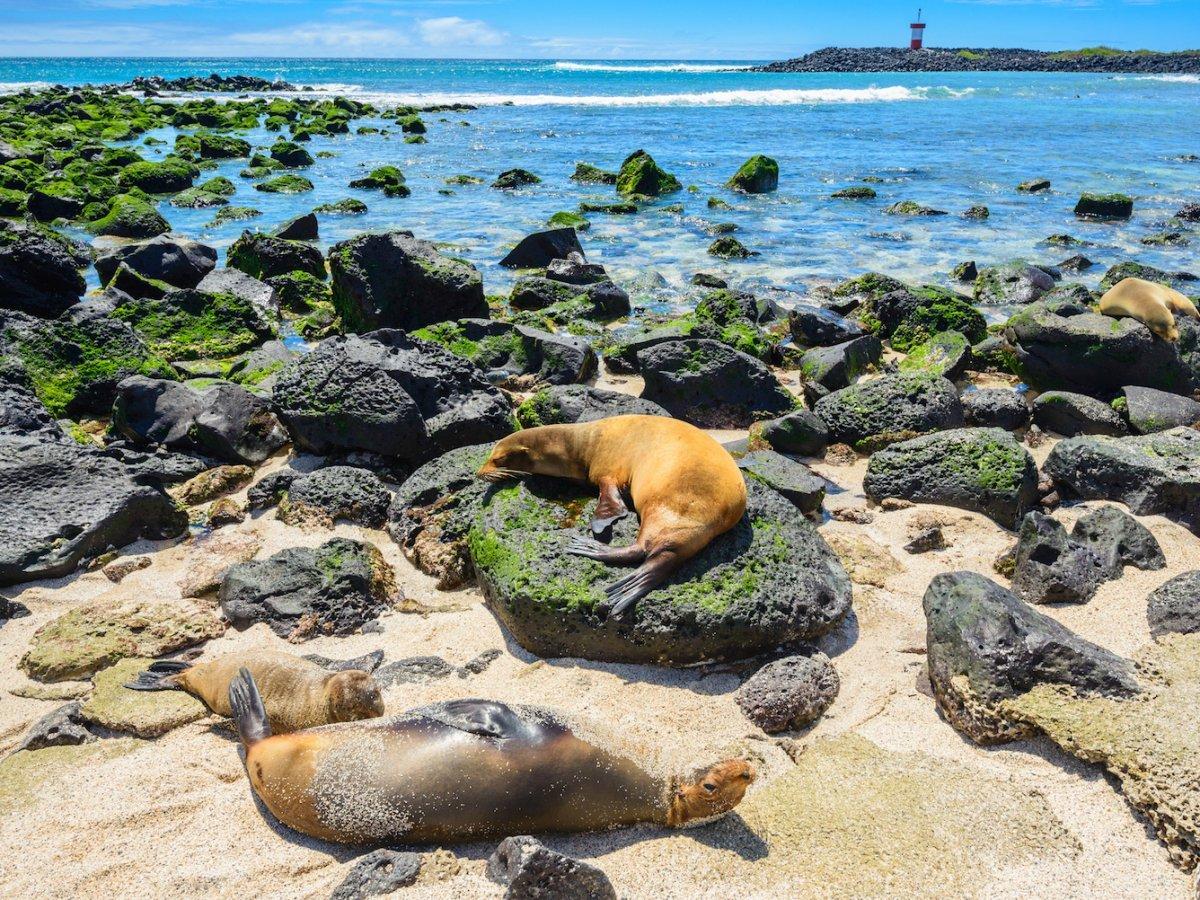How the Galapagos Islands became a guilt-free paradise
This year marks 60 years since the Galapagos Islands were designated a National Park. James Draven looks at the impact our travels have on this legendary archipelago and what’s being done to protect the world’s most famous wildlife wilderness


A sea turtle lifts her head above the water. She takes a gulp of air and briefly locks me in her gaze. She seems to scrutinise me for a moment with eyes that disappear into eternity, and I’m put in mind of the Incan goddess Pachamama, as she’s known in Ecuador, or Mother Earth to us. Then she’s gone, upending herself with a brief flash of sunlight reflecting the patterns and patina of her shell, before diving beneath the lapping waters, leaving plastic forks, plastic wrappers and glossy leaflets – which promise an eternal paradise – swirling in the eddy she leaves in her wake.
To me the Galapagos Islands are a godless place. I mean that in the best possible sense, of course: a land that has eschewed creationism and the omnipresent word of God in favour of natural selection and the benevolent narration of Sir David Attenborough – but that doesn’t stop some locals on a mission from trying to change my mind. Just behind me, on nearby Avenida de Charles Darwin, named after the author of the most comprehensive act of blasphemy ever published (which, for many, usurps religious scripture in shaping our understanding of our place in the world), Jehovah’s Witnesses stand silent vigil behind handcarts loaded with glossy, printed pamphlets assuring us of a better life after death. One that – I’m sure – would be free of ephemeral literature and single-use plastics.
Since Darwin wrote On the Origin of Species in 1859, based on his observations during his 1835 visit to the islands – and with July 2019 marking 60 years since 97 per cent of the Galapagos Islands were protected as a national park – this equatorial archipelago has become a global icon for wildlife enthusiasts. Famous for animals that show no fear of humans, having evolved quickly and independently from those elsewhere in the world, it’s become idealised as a kind of heaven on Earth, but these days the Isla Santa Cruz is some way east of Eden. (Both metaphorically and literally: the islet of Eden lies just off its western coast.)
If you’ve never visited you may be surprised; the Galapagos Islands are inhabited with all of God’s creatures – including, increasingly, a plague of human beings.
December 2019 marks 50 years since the first vessel for mainstream tourism in the Galapagos sailed, and the human impact on the islands can’t be ignored. Puerto Ayora is a bustling tourism hub with between 12,000-15,000 residents living and working here, a number that is utterly dwarfed by the 276,000 travellers that visited the Galapagos Islands last year alone.
“When I first moved here 15 years ago,” says Vanesa Bajana, acting supervisor at Finch Bay Hotel, as we stand on a main road in the El Mirador neighbourhood, flanked by a petrol station and a football pitch, “this was way out of town. There was nothing here but wilderness, but Puerto Ayora is expanding quickly.”
There are now rules to limit immigration to the Galapagos Islands, but as the current population have children, numbers are steadily increasing. And with all these people comes pollution.
The marine iguana is unique to the Galapagos Islands. Ash-black, and looking every bit as if it were born of the cinders of Hades, the world’s only sea-foraging lizard winds through the surf, its tail cranking like a hand-drill, moving through the water mechanically but gracefully. Originally arriving to the Galapagos Islands from mainland South America, having accidentally floated here on rafts of vegetation aeons ago, the humble iguana was forced to manage on these sparse, volcanic lands by venturing into the ocean to feed. Adapting to its new environment like an HR Giger alien creation thrown in at the deep end, they’ve evolved into excellent swimmers, and can dive down onto the seabed to find algae on which to feast, holding their breath for up to an hour as they do so. The ones that feed in the harbour at Baltra, where many visitors arrive by air, do so in the shadow of plastic forks. In Puerto Baquerizo Moreno, capital of the island of San Cristobal, rubbish bins overflow with carrier bags and plastic bottles.

“Fifty per cent of the 6,200 tons of garbage we generate each year is recycled,” Mario Piu, director of environmental management of the municipality of Santa Cruz, tells me as I watch his staff sift through a conveyor belt of household and commercial waste at the Fabricio Valverde recycling centre.
“It’s classified in recycle bins in town, then collected and sorted here at the plant. If all of the hotels were as diligent in sorting their rubbish and minimising their waste as Finch Bay Hotel, it would make our lives a lot easier.”
All of the recyclable materials are then sent by ship to the mainland. “There’s a carbon cost associated with that, of course, but we don’t have the facilities to actually recycle it on Santa Cruz,” says Piu. “It already costs $1.6m (£1.27m) US dollars to run this operation each year, and just 60 per cent is paid for with tourism taxes,” he explains. Eight per cent comes from the sale of collected recyclable materials, while the remainder is funded by the federal government.
“We are continuing to recycle as best we can,” Piu continues, “but we need tourists and the tourism industry to lead the way. Styrofoam is already banned in the Galapagos – that we have under control – but the national government is trying to develop a policy of only using refillable, returnable containers for beer and fizzy drinks. The regional government which takes the Galapagos entry fees is not convinced though, because it thinks that tourists want imported, bottled beers, for which we don’t have a deposit-and-return system. It approved the sodas but not the beers because it is thinking about [tourist] money. With all of the people of the Galapagos living in just the 3 per cent that is not classified as national park, tourism makes up the entire economy.”
Many argue that no tourism can ever be totally sustainable, and travel – in all its various forms – currently represents 8 per cent of the world’s total carbon emissions
If you’re thinking about what happens to the remaining 50 per cent of waste then it does, of course, become landfill – buried or burnt up in the highlands of Santa Cruz. Over 3,000 tons of landfill in the Galapagos Islands each year may seem a pretty shocking figure, but compare that to the UK where, in 2017, only 45.7 per cent of UK household waste was recycled, with two-thirds of recyclable plastics still ending up incinerated or simply thrown away. The simple truth is that, although these are global issues, we expect better for the Galapagos Islands than we do from ourselves.
Galapagos, you’ll be relieved to learn though, is far from a rubbish tip. Out on the remote islands and islets of the National Park proper, inquisitive Galapagos sea lions flop, laze, splash, and play on immaculate beaches, investigating the shutter-clattering tourists who come by to snap pictures of them on a daily basis. Giant tortoises – after whom, in Spanish, these islands were named – are much less impressed, impassively chewing leaves and regarding their photographers with nonagenarian apathy. Where the only waste seen is guano, kooky-looking boobies take turns to warm their eggs with their impossibly blue feet, swapping shifts with their life-mates with ritualistic choreography like a changing of the guard; while huge colonies of magnificent frigate birds build nests, and attract mates by inflating red, heart-shaped balloons on their necks.

As with everywhere on our planet, however, we’re never far from human activity, and, in the background, cruise-ship funnels vent nebulous gasps of black smoke into the atmosphere, reminding us that our impact on the planet isn’t always as obvious as styrofoam-choked beaches.
Many argue that no tourism can ever be totally sustainable, and travel – in all its various forms – currently represents 8 per cent of the world’s total carbon emissions. With our global trips contributing so significantly to climate change it can feel like sacrilege to fly around the world and take a diesel-guzzling cruise around Earth’s most celebrated nature reserve, but on this occasion I have nothing to repent and no sins to confess. For once, my conscience is clear because I’m travelling with an operator that is offsetting 100 per cent of my trip’s carbon emissions: from my international air travel to charging my camera batteries in my expedition cruise-ship’s cabin.
As soon as I booked my trip, an expert-certified calculator – which adheres to the strict international guidelines set by the Intergovernmental Panel on Climate Change of the United Nations – measured the total carbon footprint for my visit and quoted me around $30 USD to effectively neutralise the CO2 produced by my two-week holiday to Ecuador and the Galapagos Islands.
50%
Of the Galapagos’s household waste is recycled each year
Currently guests of Metropolitan Touring – the company that owns Finch Bay Hotel and one of the companies that pioneered tourism in the Galapagos 50 years ago, helping to draft the regulatory framework for environmentally friendly travel in Galapagos – have to consciously opt-out of this system.
“If our guests choose not to contribute then we, as a company, make that carbon-offset payment for them to ensure every Metropolitan Touring trip is carbon neutral,” Adriana Rivas, public relations coordinator for Metropolitan Touring, tells me: “But from next year we’re going to make the payment mandatory for all our customers.”
Around $30 per fortnight in the Galapagos doesn’t seem a lot to add to the bill for such a trip-of-a-lifetime destination, especially not when it’s to protect this ecosystem – the very sights we’re paying to see – for the lifetimes of our children and grandchildren.
Specifically, investment will go towards the purchase and long-term lease of forest lands in the Choco Bioregion of mainland Ecuador, with the intention being that, as this forest increases in size and health, it will absorb carbon dioxide, removing it from the air and helping mitigate climate change, as well as nurturing biodiversity in the region.
It’s been said that offsetting our carbon emissions rather than simply reducing them is tantamount to joining the RSPCA so you can carry on kicking your dog, and while tourist footfall is monitored and regulated by strict national park rules, there are no such regulations for cruise vessels. Metropolitan Touring is taking environmental responsibility seriously though, and the cruise ship on which I’m travelling – the Santa Cruz II – is equipped with biodegradable bathroom products in refillable dispensers to cut down on plastic waste; boasts top hygiene standards and environmental interpretation to prevent the introduction of invasive species to the islands; and even has its own water treatment plant – meaning it’s one of the few places in South America where you can drink from the tap. Accordingly, no plastic bottles are available onboard, with guests refilling their complimentary metal flasks with chilled, purified water.
On my last night, the waters around the ship are teeming with life. A huge shoal of flying fish darting above the ocean around us has attracted around 50 Galapagos sharks that now surround our vessel. Lacerating the atmosphere, they slice through the sea with silent menace beneath the frantically beating “wings” of fish making frenzied attempts to evade them. Some fly distances of over 100m only to be intercepted by the jaws of sharks which launch their 3m-long bulk into the air like intercepting quarterbacks, sparking a feeding frenzy in which the seas boil around us. Scores of panic-stricken fish hurtle into the side of our ship, thudding against the hull – striking a passenger in one instance – and landing on the deck, flapping and writhing as they drown in fresh air. I consider grabbing them by their tails and hurling them back out to sea, but they’d only meet a worse fate amid those churning waters, and so – caught between the devil and the deep blue sea – I do nothing at all.
Inaction is not a luxury we can afford when it comes to protecting our planet’s few remaining wildernesses. On Puerto Ayora’s harbour, on the island of Santa Cruz, stands a church whose stained-glass windows project not angels and demons onto the rows of pews below, but simple leadlight images of the Galapagos waved albatross and of dolphins. Even in this house of God, it seems the locals know that their wildlife is their life line, and that ultimately, whether creationist or evolutionist, it’s the goddess Pachamama – planet Earth – that we should most revere.
How to get to the Galapagos Islands
James Draven travelled with Journey Latin America (journeylatinamerica.co.uk, 0203 553 9647), the UK’s leading specialist in travel to Latin America. A 16-day holiday to Ecuador – staying one night in Guayaquil, two nights at the Finch Bay in Galapagos, followed by a six-night cruise on the Santa Cruz II ship, two nights at Casa Gangotena in Quito, and two nights at Mashpi Lodge – starts from £8,330 pp. The price includes flights, transfers, first-class accommodation, most meals, excursions and the Galapagos National Park entrance fees.
Join our commenting forum
Join thought-provoking conversations, follow other Independent readers and see their replies
Comments
Bookmark popover
Removed from bookmarks